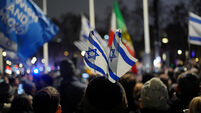Iraq releases death toll figures
Iraq has reported that about 12,000 civilians were killed last year – the third full year since the US-led invasion – with a dramatic rise in the last three months, when 5,000 died.
Only about half as many Iraqi soldiers died in 2006 as American troops.
But the number of Iraqi security forces killed jumps to 1,539, nearly double the American death count for the year, when the deaths of police, who conduct paramilitary operations, were added to the number of slain Iraqi soldiers.
In all, the Iraqi ministries of Health, Defence and Interior yesterday reported a total of 13,896 Iraqi civilians, police and soldiers died last year, a figure that is only 162 greater than the tabulation kept by The Associated Press.
The AP count, assembled from its daily news reports, was always believed to be substantially lower than the actual number of deaths because the news organisation does not have daily access to official accounting by the Iraqi ministries.
While the US government and military provide no death totals for Iraqis, the United Nations Assistance Ministry for Iraq, UNAMI, does keep a count based on reports it gathers from the Baghdad morgue, Ministry of Health, and Medico-Legal Institute.
The figures for November and December are not yet available from the UN, but as of the end of October the organisation had reported 26,782 deaths in the first 10 months of 2006, nearly double what the Iraqi government and the AP reported for the entire year.
In its last report, the UN said 3,709 Iraqi civilians were killed in October alone and that citizens were fleeing the country at a pace of 100,000 each month. The organisation estimates at least 1.6 million Iraqis had left since the war began in March 2003.
At the time of the last UN report, Iraqi government spokesman Ali al-Dabbagh called it “inaccurate and exaggerated” because it was not based on official government reports.
The UN report said Iraq’s heavily armed and increasingly brutal Shiite militias were gaining strength and influence and that torture was rampant, despite the Iraqi government’s vow to reduce human rights abuses.
“Hundreds of bodies continued to appear in different areas of Baghdad - handcuffed, blindfolded and bearing signs of torture and execution-style killing,” the last UNAMI report said. “Many witnesses reported that perpetrators wear militia attire and even police or army uniforms.”
The two primary militias in Iraq are the military wings of the country’s strongest Shiite political groups on which Prime Minister Nouri al-Maliki is heavily dependent. He has repeatedly rejected US demands that he disband the heavily armed groups, especially the Mahdi Army of radical anti-American cleric Muqtada al-Sadr.
“I think the type of violence is different in the past few months,” Gianni Magazzeni, the UNAMI chief in Baghdad, said when the last report was issued in late November. ”There was a great increase in sectarian violence in activities by terrorists and insurgents, but also by militias and criminal gangs.”
UNAMI’s Human Rights Office continued to receive reports that Iraqi police and security forces have either been infiltrated by or act in collusion with militias, the report said.
It said that while sectarian violence is the main cause of the civilian killings, Iraqis also continue to be the victims of terrorist acts, roadside bombs and drive-by shootings, while some have been caught in the cross fire between rival gangs.
In its September 2006 issue, the “Lancet”, an independent and authoritative journal, published a study on mortality rates in Iraq.
The study estimated that 654,965 excess Iraqi deaths, including 601,027 from violence, had occurred in Iraq since the invasion of the country in March 2003.
The “confidence range” for the number of excess Iraqi deaths because of violence has been estimated between 426,369 and 793,663 with the figure of 601,027 as the median number.
The US government and Iraq as well as others, including the Iraq Body Count, an organisation which has conducted other types of surveys, denied the validity of the study’s findings.
The Iraqi Minister of Health, in a statement made in Vienna, in early November, indicated that as many as 150,000 Iraqi civilians might have been violently killed since 2003. But there are no known statistics for the early months of the US-led invasion.
After an extraordinary violence-free start to 2007, Iraqi authorities reported yesterday that at least 57 Iraqis were killed in sectarian violence, including 45 tortured bodies that were found dumped in Baghdad and five in Kut to the south.
Three Iraqi civilians were killed in a roadside bombing yesterday morning in eastern Baghdad, police reported.
In Baqouba, gunmen killed Diyala provincial council member Ali Majeed and three members of his family.
The military announced the death of a US soldier by a roadside bomb southwest of Baghdad. The blast on Monday wounded three others, including an interpreter, as they talked to residents about sectarian violence, the military said.
US troops killed a suspected al-Qaida weapons dealer and two other people in Baghdad raids yesterday.
In Fallujah, a US Marine fatally wounded an Iraqi soldier in an altercation at the guard post they shared, the US military said.
The confrontation took place on Saturday between members of US and Iraqi units assigned to combined security posts at the Fallujah Government Centre. The Marine – assigned to the 1st Battalion, 24th Marine Regiment, Regimental Combat Team 5 – has been assigned to administrative duties while the military investigates.














